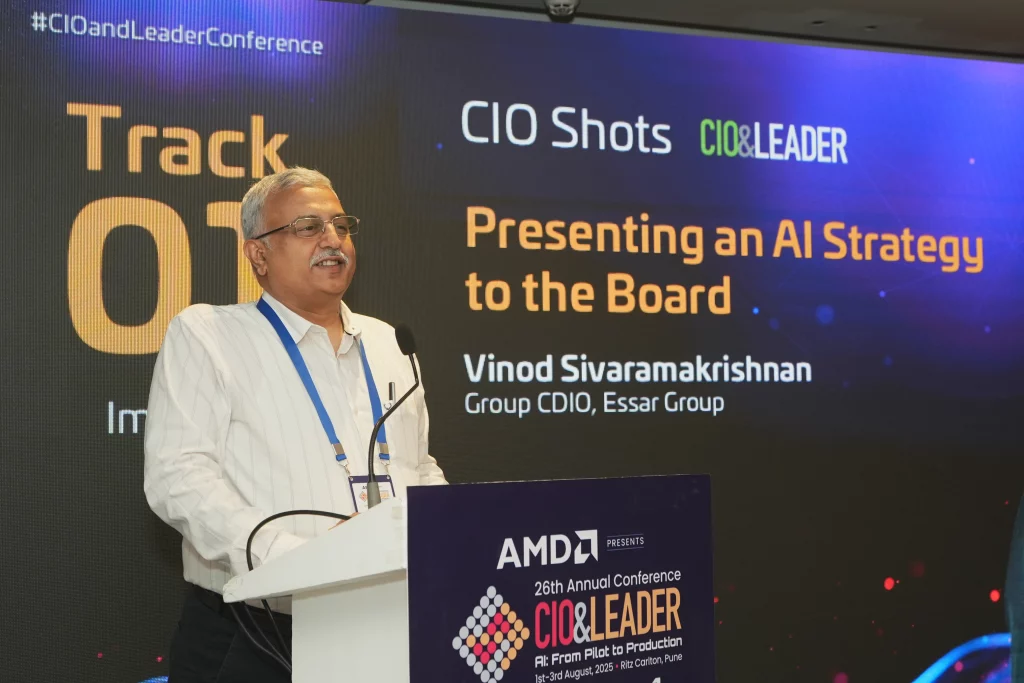Vinod Sivaramakrishnan, former Group CDIO, Essar Group, on presenting the AI strategy to the Board.

As a former CDIO at the Essar Group and having occupied senior IT leadership positions in GE, Walmart and Indus Towers, Vinod Sivaramakrishnan has spent decades in boardrooms, bridging the gap between technology and leadership. His message was clear: delivering an AI strategy isn’t just about technology; it’s about clarity, trust, and foresight.
If you can’t explain something to a five-year-old, you don’t understand it well enough.” Richard Feynman’s timeless advice was the closing note of Vinod Sivaramakrishnan’s keynote on presenting an AI strategy to the board.
Why Presenting to the Board Is Both Opportunity and Threat
Sivaramakrishnan highlighted that presenting to the board is more than a procedural exercise. It serves as a platform for educating, reassuring, and aligning leadership. Boards, by nature, are cautious and often demand reassurance that management has a clear stance on emerging issues, such as AI or cloud.
But the stakes are high: a poorly delivered presentation can cast doubt on leadership potential, leave strategies hanging in limbo, or worse, create detractors within the boardroom.
What Boards Really Want: Effort, Clarity, and Conviction
According to Sivaramakrishnan, boards care less about buzzwords and more about demonstrating work done. They want evidence comparisons with competitors, engagements with partners, and alignment with global standards. Without this, strategies appear flimsy.
He advised presenters always to articulate:
- Where we stand today.
- Where are we heading?
- It will take resources, partnerships, and risks.
- How success will be measured.
“The conviction has to come across,” he said, stressing that boards expect diligence as much as vision.
Designing a Strategy: Vision, Reality, and the Sweet Spot
For Sivaramakrishnan, strategy is not a plan or a checklist. Instead, it is a narrative of how an organization intends to move from its current state to its desired future.
He warned against blending vision, aspiration, and commitment into one ambiguous slide, a common mistake that leaves board members interpreting promises differently. Instead, presenters must clearly distinguish between what is aspirational and what is actionable.
Equally important is striking the “sweet spot” of complexity. Too much jargon, and the board tunes out; oversimplify, and they disengage. The trick is layering complexity, providing basic overviews, adding detail when asked, and pushing technical content into appendices.
Handling the Unexpected: False Equivalences and Hypotheticals
One of the keynote’s most striking insights was how to manage curveballs. Sivaramakrishnan recalled moments when board members drew false comparisons, such as equating a son’s personal finance software installation to a global Oracle rollout, or posed unanswerable hypotheticals, like nuclear attack scenarios.
His advice:
- Welcome feedback calmly.
- Distinguish between operational and strategic issues.
- Defend principles, not specifics.
- Use the CEO and CFO to refocus discussions.
Preparation, he emphasized, is as much about anticipating distractions as it is about presenting content.
The Golden Rule: Show the Work, Not Just the Dream
To win trust, Sivaramakrishnan recommended always showcasing the effort behind the strategy, benchmarking competitors, engaging consultants, or conducting field research. “Boards love pictures,” he added, urging presenters to make strategies visual, engaging, and credible.
On cost, he was unequivocal: never give a single number. Instead, provide ranges and options like a restaurant menu, showing preparedness without committing prematurely. A fixed number, he warned, will only backfire.
The Essence of Boardroom Success
In closing, Sivaramakrishnan reminded the audience that presenting an AI strategy to the board is not a battle to win but a dialogue to enable. It is about creating room for discussion, inviting participation, and leaving directors reassured that the company is not only aware of AI’s possibilities but actively shaping its path.
Above all, presenters must keep their explanations clear enough that even a child could understand them. In the boardroom, simplicity is not a weakness; it is the ultimate proof of mastery.